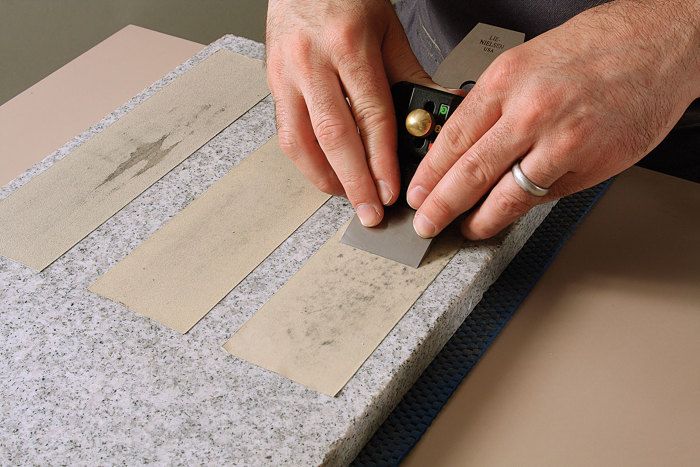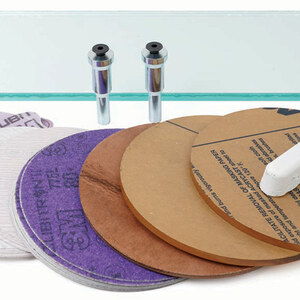
I should probably start by listing the 9 reasons, right? OK. Here they are:
- 1 micron
- 2 microns
- 3 microns
- 4 microns
- 5 microns
- 6 microns
- 7 microns
- 8 microns
- 9 microns
But that list probably just adds to the confusion. So, watch the video. It’s from a hand planing competition in Japan. This video (and another one) have been popping up on woodworking forums and blogs recently. What you’ll see is a fine gentleman taking a shaving that is 9 microns thin. How thin is that? Well, I know that here in the Western woodworking world, we often brag about shavings that are 1 or 2 thousandths thick. There are 25.4 microns in one thousandth of an inch. So, a shaving that is 9 microns thin is just a bit more than one third of one thousandth of an inch. And those guys are taking full width, full length shavings that thin! (And, more importantly, the surface left behind by that blade has got to be perfect.) That’s how I know I don’t sharpen as well as I could. I can’t do that.
After you’re suitably impressed by that video, check out this other one. It’s impressive because the guy is taking a super thin shaving with a wickedly wide plane. The blade has got to be at least 9 in. wide. Notice how heavily the guys using it are breathing when they’re done. Must be a bear to pull.
Finally, let me give a loud shout out to my friend Wilbur Pan. I first came across the second video on his blog, Giant Cypress (great blog), and that led me to the first video.






















Comments
You may not be able to do that, but its ok. No one needs to sharpen to that level unless the goal is to win a planing competition.
Thats pretty awesome! But can he build an occasional table!!
These are fun videos, I caught them last week some time on FB.
I guess if you spend that much time shapening then where is the time for working...just saying ;)
Now let's see, how many passes would it take for me to remove that last 1/32 of a inch to get down to my scribe line with that guy's plane? That many? Really? I'd go broke. Think I'll just stick to the everyday challenge of trying to make a living with woodworking.
Now, if someone can pull a shaving like that off curly bloodwood….. I suspect they are cutting very consistent quarter sawn spruce or other very homogeneous wood. Still, very impressive.
Right up there with underwater basket weaving.
Sorry to disagree with all these comments but I thought this was AWESOME!!! Like climbing Mt. Everest. It's the "challenge!"
The event is called Kazaru Kai (planing competition) and was started in the mid-nineties in Japan as a way to "...encourage the preservation of traditional Japanese woodworking methods." It's an annual event that has drawn alot of attention and even found its way here in the U.S., at least in the recent past. It looks wicked fun, and I applaud these Japanese woodworkers for doing their part in promoting traditional woodworking. You can read a short blip about it here - http://swingleydev.com/archive/get.php?message_id=99801&submit_thread=1
These competitions are just meant for fun - no one suggests that they are superior woodworkers because they make thinner plane shavings. Obviously, the focus should be on what's left after you plane, not the shaving that comes out that you throw away. However, these types of events can still be fun.
I thought the 2nd video of the very large plane was interesting. I wonder why we don't use larger planes. Obviously they can get very hard to pull (or push for us westerners), but I've often thought tasks would be easier if I were taking thinner shavings at a larger width, and it would be simpler to ensure board flatness. As it is I use a 4 1/2 for smoothing most of the time (with a 55 frog) - and it's not bad to push, although noticeably harder than a 4 with a standard pitch. You have to wonder why they don't add some sort of a grip though for pulling a plane that size... Ease of gripping has always been my biggest reason for preferring Western style planes.
But surely this is more about the plane setup and adjustment, than simply sharpening... The sharpest blade in the world can't do this if the blade is skewed, or set too deep. And that's all done by hammering on the plane blade and body. Now that's a subtle skill!
What was the type of wood they were planning? The grain pattern and cellular structure would have to tight, straight and small to support this amazing demonstration.
Does the story go on to read "... it took a master blacksmith a year to produce the large plane blade and the plane maker another year to perfect the plane and someone had the money to pay for it all...". Awesome.
The wood is Cryptomeria japonica. Japanese call "Japanese cedar"...it is not a cedar but cypress. It is a single species that grows in temperate rain forests at a specific range of elevations. Best place to see them is Yakushima....a Pacific island off the SW coast of Japan and UN World Heritage site http://www.google.com/url?sa=t&rct=j&q=&esrc=s&source=web&cd=1&cad=rja&ved=0CDUQFjAA&url=http%3A%2F%2Fwhc.unesco.org%2Fen%2Flist%2F662&ei=EKofUaXvEIyN0QH8-YDQBg&usg=AFQjCNHmAwfVmk7FaV4v0mBi8SlIGm1_Eg&sig2=z-KGUhhNcvpp76xK3hJQEg&bvm=bv.42553238,d.dmQ
Bring rain gear!! Some of the trees are around 7000 years old....1000 year old trees are referred to as "Young cedars"
That last guy's day job is making veneer for Home Depot plywood.
I was a competitor in the Kazuru Kai competition held in Berkeley a number of years ago. The wood we were using was Port Orford Cedar. The Japanese masters were visiting brought the wide plane as well for the paper size slices. I got below a thou, but actually a "Westerner" with his own Krenov style plane was even thinner.
No one was sharpening with jigs, but all just by hand on Waterstones. It was great fun!
"9 reasons why I don't sharpen my plane blades as well as I thought"
Here is one reason I sharpen as good as I need. I am more concerned about the wood left on the bench than the wood left on the floor.
As with everything in life there comes a point of diminishing returns, I suspect 9 or 5 micron shavings are such the case.
You people have way too much time on your hands. Go build something instead of watching videos of guys with even more time on their hans
Love the wide plane. That is insane! Back in the real world, I find an 8,000 grit waterstone to be the sweet spot for me. Takes me only a couple of stones (1,200, 4,000, 8,000) or get there, and it leaves the edge plenty sharp for the toughest woods.
The French say, "Chacun a son truc." I translate that as, "everyone has their thing." and by thing, it's the thing you can't explain. I can't explain exactly why these dudes are so devoted to whisper thin "gossamer" (as Roy and Chris put it on the Woodwright shop) shaving? But they clearly are having a ball and no one on the planet knows how to go 100% at something so esoteric as the Japonese. Yea, I am with the guy more interested in what's on the bench, but that's my thing, my "truc." I've made boats and it's great fun, but for me I'd rather be sailing. Some guys like making tools, more than making furniture.
Maybe these guys are like racecar drivers, they are working on cutting edge technology and technique that will benefit us all some day. Thanks for sharing the videos, good fun.
Now get back to work, that project isn't going to build/paint/sharpen/plane/join/whatever itself.
Thats is truly incredible! You should do an article with one of these guys about sharpening. I know we don't need to go to that level for building furniture, but I would think a guy could sure learn something from their technique.
mrd76's comment about large planes and how hard they are to pull or push reminded me of a visit to Colonial Williamsburg several years ago. They had a demonstration of them making crown molding that must have been 9 or 10 inches wide. It was done with a plane.
I hesitate to call it a "hand plane" as the molding production was a two-man operation. One guy held and guided the plane while the other pulled on a stout rope attached to plane. The "rope guy" operated like a draft horse pulling a wagon. He was sweating up a storm in a short while.
Amazing...what type of wood and type of plane is being used?
One thing to remember is the steel they are using is hand forged. You can't sharpen even O-1 that fine because the carbides in the steel form into "balls" of a large enough size that honing finer than an 8000 grit stone does no good.
Hand forging steel involves pounding on it with a hammer and has the effect of breaking up the carbides, resulting in a finer grained steel in the process, which will take a finer edge.
Aw, heck, I knew a guy that would run off a few one-sided shavings then go out hunting magnetic monopoles, all before lunch!
I'm still looking for a good video on setting up a smoothing or jack plane.
I don't see a video mentioned.
Log in or create an account to post a comment.
Sign up Log in